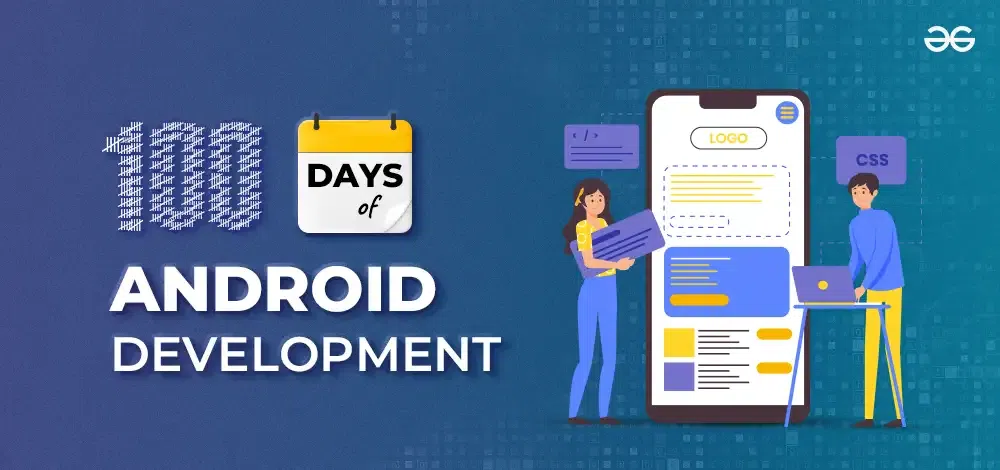In the dynamic world of Mobile application development mastering in developing applications is not just a skill but rather a journey. Welcome to the 100 days of Android Development journey where we will dive into different Android development important components day by day. The definition of Android Development of Android to the advanced Android component will be covered in this article.
In this article for Android apps, we will take native app development using Kotlin or JAVA and cross-platform development Flutter too. Embarking the 100-day journey into Android App Development would be a very exciting and rewarding endeavor for beginners. Join us on the journey of 100 Days of Android development where we will go through a series of exercises that will help us to understand core Android concepts strongly.
What is Android Development?
Android development is a process of creating Android applications that can run on devices having an Android Operating System. Andy Rubin the father of the Android Operating System, founded it in 2003 which was acquired by Google in 2005. Android operating system can run on various types of devices like smartphones, tablets, smart TVs, and smartwatches.
Android Software Development Kit (SDK) to build, test and debug Android applications. Initially, Android applications were developed using Eclipse IDE but later in May 2013, Google announced Android Studio as the official IDE for Android Applications development. Initially, the programming language for Android app development was Java, but later Google announced Kotlin as the official Android development language which was much safer and concise than Java.
Why to Choose Android development
Below are key reasons why one should choose Android Development as a career.
- Market Share: Android is very popular and covers approximately 69% market share. Android is a leader in terms of the number of users using Android devices.
- Open Source: Android is an open-source language, which is one of the reasons that attracts developers more as it gives developers the liberty to customize the operating system.
- Large Community: The Android developer community is very large where developers share their knowledge and best practice ideas. Creators and maintainers of the Android Operating system held an Android Key not event each year to reveal their new features and tools, that help to keep their community stronger and more active.
- Job Opportunity: Since Android is a very popular operating system, the requirements of highly skilled developers are also very high. Companies always actively looking for Android developers.
- Large User Base: Android operating systems run on a variety of devices manufactured by different companies. It has a large user base as those companies provide different types of devices in terms of size, configuration, and budget. Due to the large user base, it keeps Android developers’ requirements high.
Let’s start our 100-day Android Application journey.
100 Days of Android Development
Before beginning the 100-day Android Development journey, consider your passion, career flexibility, job market demand, and industry trends to ensure a well-informed and successful learning experience. Now, Let’s start our 100-day journey of Android Development.
Day 1-10: Setup and Installation
Our initial journey will start with basic setup like understanding S/W and SDK requirements along with Installing them. In this 10-day journey, we will make ourselves comfortable with IDE understanding and will create a Hello World Application.
| Android Native | Cross Platform – Flutter | |
|---|---|---|
| Understand the basics: (Day 1-5) | Familiarise yourself with Kotlin or Java for Android native development. | Familiarise yourself with Dart for Flutter Android native development. |
| Install Android Studio: (Day 6-7) | Set up Android Studio and SDK by installing mandatory packages. | Install Flutter and Dart SDK along with IDE (Android Studio or Visual Studio) |
| Create your First App: (Day 8-10) | Create your First Android app using KotlinSet up/Java | Create your First Flutter Application |
| Explore IDE and make yourself familiar with its structure, editor, and tool windows. also understand the role of Gradle in Android development | Explore IDE like Android Studio, Visual Studio Code, and IntelliJ IDEA to make further development quick. |
Day 11-30: Diving Into UI/UX Design
After completing our first 10-day journey now it’s time to dive into UI/UX designs. In this phase, we will learn the basic layout, Views, Widgets, and how to enforce validation on input fields. After completion of this journey, we will be able to create UI screens for Android applications. We will also have a glance at the lifecycle of activity and views, which is very important for navigation and screen flows.
| Android Native | Cross Platform – Flutter | |
|---|---|---|
| UI Layout: Day (11-15) | Layouts – Row, Column, Grid. | |
| Views: Day (16-20) | Widgets and Views | Widgets and Elements |
| Lifecycle: Day (21-25) | Activity Lifecycle | Widget Lifecycle |
| User Input and Validation: Day (26-30) | Form validation | Form validation |
Day 31-50: Mastering Functionality
Now it’s time to jump into the functionality part, this is a very important phase as it will deal with application flow. In this phase, we will learn navigation, state management, local data storage, and API calling things. Developers need to pay more attention in this phase because from this phase developers have to play with business logic. A clear understanding of navigation helps developers to create an app flow seamlessly and efficiently.
A good grip on states helps developers to create apps that could be best in terms of performance. Database and Network call learning phase will help developers store and retrieve data in the best way and display them to the user.
| Android Native | Cross Platform – Flutter | |
|---|---|---|
| Navigation: Day (31-35) | ||
| Intents and State management: Day (36-40) | ||
| Local Storage: Day (41-45) | ||
| Network Call: Day (46-50) |
Day 51-70: Enhancing User Experience
In this phase of our journey, we will pay attention to making user experience better. We will learn Animation, Localization, Firebase Integration, and Permission models in these days of our journey. For the Android platform, we will have to look into Work Manager and Coroutine in this phase, which plays a vital role in Application performance.
- Animations are very useful in getting the attention of end users, having animations in apps increases the user’s experience in the App.
- Permission takes care of user’s data safety and does not allow apps to use user’s data until permission is granted by users.
For Web or App development Firebase provides many features that developers can’t skip in the learning phase. We will learn all Firebase features in this phase.
| Android Native | Cross Platform – Flutter |
|---|---|
| Fragments: Day (51-53) | Customise Design: Day (51-53) |
| Notification: Day (54) |
Responsive Design: Day (54) |
| Permissions: Day (55) | Internationalization: Day (55) |
|
Animations: Day (56-58) |
Animations: Day (56-58) |
|
Firebase: Day (59-65) |
Firebase: Day (59-65) |
|
Coroutines: Day (66-69) |
Fonts Exercise: Day (66-69) |
| Work Manager: Day (70) | Streams in Dart: Day (70) |
Day 71-90: Advance Learning
Time to move towards some advanced topics like Architecture – Very important for maintaining large-scale projects, Dependency Injections – Important for Code re-usability, and Unit testing – Needed to check code does not break in new implementations. Choosing the correct Architecture will help in maintaining long-term and large-scale projects. Dependency Injections are quite tricky to add to projects. It might take some time to understand but once it’s added it saves lots of time for developers.
| Android Native | Cross Platform – Flutter | |
|---|---|---|
| Architecture: Day (71-78) | ||
| Dependency Injection: Day (79-84) |
|
|
| Unit Testing: Day (85-90) |
Day 91-100: Continue Learning and Real-World Projects
After completing 90 days of our journey, we will enter into the last 10 days where we will learn the basics of Version control, CICD pipeline – to make the build process automatic so the tester can take testing build directly, Deployment – Publishing app to Play store to make applications available to end users.
A large number of open-source projects are available on the web which are developed by experienced developers, forking those projects and reviewing their code helps developers to follow best coding practices.
- Version Control: Day (91-92)
- Fork and Contribute to Open-Source Projects: Day (93-94)
- Join Developers Community: Day (95)
- CICD Integration: Day (96-98)
- Deployment and Publishing: Day (99-100)
Conclusion
In conclusion, the 100-day journey of Android Application Development, whether for native or cross-platform development, offers a transformative experience. From grasping foundational concepts to mastering advanced topics like architecture patterns and deployment, each step is crucial in becoming a proficient app developer. By considering your passion, career goals, job market demand, and industry trends, you can make informed decisions that will shape your learning journey and future career in Android development.





